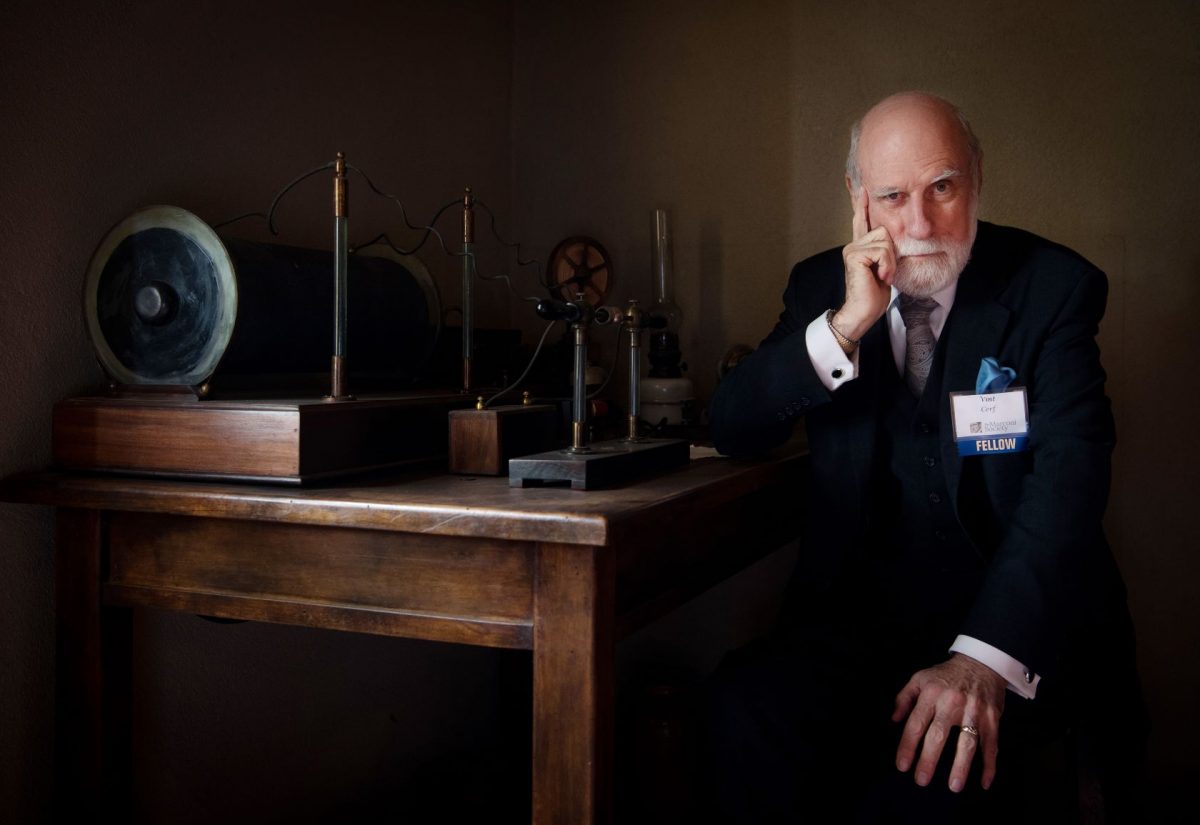
Pubblichiamo il talk presentato da Vint Cerf in occasione della Giornata di Marconi 2021, per i 126 anni dei primi esperimenti di telegrafia senza fili di Guglielmo Marconi
MARCONI’S LEGACY
Vinton G. Cerf
It is now 126 years since Marconi’s fateful encounter with Celestini Hill and the successful transmission of radio signals over two miles away to a simple detector called a coherer that changed its resistance when it encountered electromagnetic radiation. Marcon’s experiments and subsequent successes echo down the decades to the present day, inspiring and challenging us to continue to push the boundaries of our knowledge and use of the electromagnetic spectrum. We may imagine the excitement he generated in December 1901 when he successfully demonstrated the transmission of signals between Cornwall and Newfoundland at a distance of 2200 miles. I understand that the signal rate at the time was about 1 bit every six seconds. Ironically, my own experiences with the design and test of the Internet echoes this pace. In tests between Stanford University and University College London in 1975, we achieved a rate of three packets per second with our very early implementations of the Transmission Control Protocol. Of course, the path our packets took involved a round-trip through a synchronous satellite hop at 9.6 kb/s and back and forth across the US on 50 kb/s dedicated telephone circuits.
By 1912, wireless telegraphy was in use for ship-to-ship and ship-to-shore communication and Marconi gained international attention when the sinking Titanic signaled its distress using Marconi’s wireless telegraphy to send an SOS message calling into the ether for help. The rest, as they say, is history.
The Marconi Society here in the United States celebrates Marconi’s accomplishments along with the Fondazione Marconi. We are inspired by his work and seek to inspire others. Founded in 1974 by Gioia Braga, Marconi’s youngest daughter, the Marconi Society has celebrated the accomplishments of entrepreneurs, inventors and researchers every year with a $100,000 Marconi Fellowship. In more recent times, we have undertaken to organize an annual symposium and in 2008, thanks to a major grant from one of our Marconi Fellows, Paul Baran, the Society started a Young Scholars award program to recognize early and notable accomplishments by researchers under the age of 28. On their own initiative, our Young Scholars started a Celestini award program for students who undertake projects with the guidance of Young Scholar volunteers. This program highlights hands-on solutions to local problems whose solutions lie in the application of information and communication technologies. These efforts have taken place in India, Uganda, Rwanda, Ghana and Colombia.
In 2019, we began a new phase of the Society’s mission by the addition of a new program centered on what we call Digital Inclusion, thanks to the initiative of our Executive Director, Samantha Schartman-Cycyk who came to the Society with a history of enthusiasm and success in this domain. The Celestini program has been revised and expanded to include hands-on training with the implementation and operation of Internet communications in addition to research projects aimed at solving local problems. We have programs under way in Uganda in cooperation with the National Research and Education Network of Uganda (RENU) on the Makerere campus and in Ohio in cooperation with Case Western Reserve University. An important focus of the latter is on the inclusion of underserved cohorts including women and students of color.
For several years now, the Marconi Fellows, Young Scholars and other experts have made themselves available to communications regulators for consultation on such matters as E911 (emergency calls) and 3D intra-building location in emergency situations such as fire.
A significant element of Digital Inclusion involves identifying where Internet is available and at what level of performance. Working with Code for Science and Society, the Measurement-Lab and Google, the Marconi Society is collaboratively developing tools for mapping performance data obtained by voluntary crowd sourcing (such as using “speed test” web sites) to aid in the allocation of new resources for building out Internet infrastructure to improve access where it does not exist or is underperforming. This is a global initiative and recent proposed legislation in the United States has triggered substantial interest in this program.
Some of you may recall that the mathematician, David Hilbert, posted 23 unsolved problems in mathematics in 1900. Of course, there were many more such problems but his posting drew the attention of the mathematics community. A number of his problems are still unsolved or are the subject of continued debate. This effort to focus attention is mirrored in other disciplines such as astronomy, high energy physics, biology and other scientific fields. So-called “decadal” studies are conducted by the research community to reach consensus on the most valuable areas deserving of research support and pursuit. By way of example, planetary researchers have organized an ambitious series of missions to Mars to achieve sample return to Earth in the 2020s, in consequence of such decadal studies. New space telescopes such as the James West space telescope and the Vera C. Rubin observatory (formerly the Large Synoptic Survey Telescope) have been developed also in consequence of community consensus.
The Marconi Society has initiated a series of decadal discussions about Information and Communication Technology during 2021, probing the community for the most important problems whose solution would lead to significant breakthroughs in information and communication capabilities. The topic is broad and we have had discussions about chip architecture, quantum computing and networking, cryptographic applications, new signaling and modulation schemes, antenna design, among many others. It is our plan to organize a symposium on October 22 in Washington, DC to explore and prioritize these challenges and to celebrate the first Marconi Fellowship awarded to a woman, Andrea Goldsmith, now the Dean of Engineering at Princeton and formerly a long-serving faculty member in Stanford’s Electrical Engineering department.
The participation of the Fondazione Marconi and its members would be most welcomed in this decadal study initiative and, of course, the October Symposium. I am very happy to acknowledge Marconi Society Board Member Giovanni Corraza’s contributions to planning and participation in the October events and the decadal studies.
The expansion of the Marconi Society’s mission is timely given the evident role of the Internet and information and communication technologies in general during the continuing pandemic that has gripped the world and caused so much social and economic devastation to say nothing of lives lost or seriously injured. Many of us, the lucky ones, spend our days online collaborating via video conferences as we are doing now, or exchanging emails, surfing the World Wide Web and carrying out research and business transactions. Online entertainment has become an enormous business and we have been forced to find ways to use online resources so people can work from home and children can attend school remotely.
We have also discovered during this period that supply chains are brittle especially when the pandemic has forced us to socially distance. So much work involves proximity and many workers have been unable to pursue their livelihoods. Even when work and education can be undertaken online, the capacity of Internet access or availability of computing equipment at home is often inadequate. This deficit gives added impetus to our interest in Digital Inclusion. Adding to the challenge is our discovery that social media such as Facebook, YouTube, Twitter, Instagram, WeChat, and many other applications are sources of misinformation, disinformation, bullying, fraud and other abuse. These are not easy problems to solve but they demand responses. It will take a combination of regulatory policy, public education, business incentives and perhaps some advanced machine learning methods to tackle them successfully. I have become persuaded that technologists need the help of sociologists, anthropologists, neuroscientists and psychologists to understand more deeply how social media are used and abused. Moreover, cyberattacks abound, harming governments, institutions of all kinds and the general public. The challenge is international in scope, especially considering law enforcement and the need to identify and apprehend perpetrators of harm whose victims may be anywhere in the world where the Internet is available.
We do not lack for challenges in the domains opened up by Marconi’s successes. It is exactly these challenges and Marconi’s examples that drive both the Marconi Society and the Fondazione Marconi towards solutions requiring leadership, technical expertise and vision. Marconi would expect no less of us than to meet these challenges head on, most especially encouraging our youth to find new answers to solve them.

